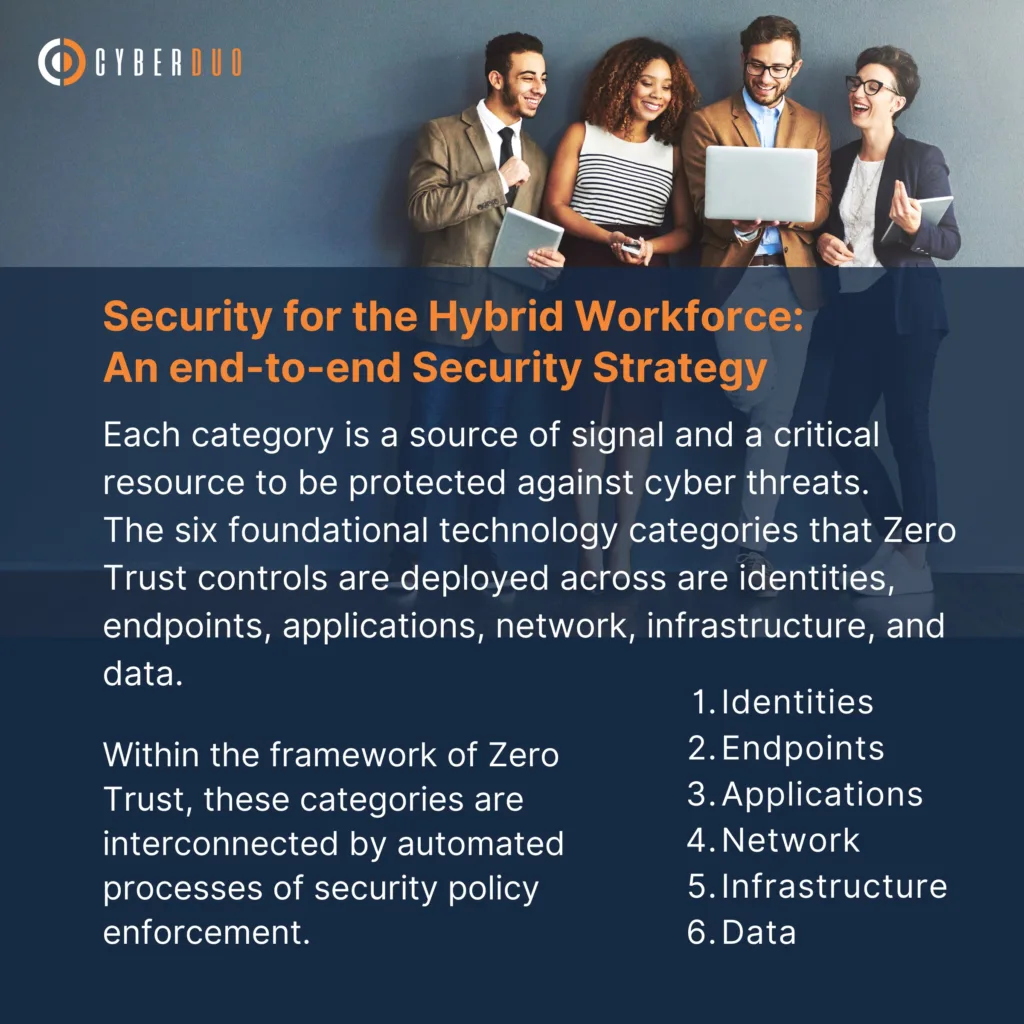
More businesses are adopting a hybrid or fully remote workplace. This shift is driving broader adoption of the Zero Trust strategy to secure apps and data.
The six foundational technology categories that Zero Trust controls are deployed across are identities, endpoints, applications, network, infrastructure, and data. Each category is a source of signal and a critical resource to be protected against cyber threats.
Within the framework of Zero Trust, these categories are interconnected by automated processes of security policy enforcement.
1. Identities
Identities signify people, IoT devices, or services. If an identity is attempting to access a resource, that identity needs to be verified with strong authentication and must be confirmed the access is compliant, as well as typical for that identity. Least privilege access principles within Zero Trust needs to be implemented and followed. Identity attacks are mostly related to passwords, so updating and enhancing passwords can help security. However, the most secure and productive authentication process is completely eliminating the need for passwords through passwordless protection methods such as MFA, biometrics, authenticator apps, etc.
The Conditional Access security policy in Azure AD is an approach for granting least privilege access and verifying explicitly, which means the identities use strong authentication when trying to gain access to resources. Administrators utilize conditional access to enforce additional requirements whenever needed to grant access to a user trying to access apps and resources.
2. Endpoints
After the authentication process, an identity is granted access, and data can now flow to different endpoints, such as on-premises workloads, IoT devices, smartphones, at-home devices, partner-managed devices, and cloud-hosted servers. The availability of diverse endpoints creates a large-scale attack surface, so monitoring and enforcing device compliance and health is a good way to ensure access security. As the world leaned more toward a more remote or hybrid workforce driven by necessity, users started working from and accessing work resources from anywhere and on any device. Attackers quickly adjusted. They continue to perfect attack tactics and take advantage of this shift. Organizations are facing challenges enabling end-users access to digital resources that in the past required VPN or on-premises access and pondering the risk of users unintentionally installing malware while using personal devices for non-work reasons.
Through the Zero Trust model, organizations can mitigate the risk and reduce costs by avoiding additional hardware purchases for remote/hybrid workers. It is essential to make sure extensive and continuous verification of device and user identity runs seamlessly without hampering productivity and securing access to resources.
3. Applications
Applications serve as the interface through which data is consumed. Apps may be on-premises, on the cloud, or modern software as a service (SaaS). Apply controls to ensure correct in-app permissions, utilize real-time analytics to gate access, and monitor abnormal behavior.
Identities, apps, and services are becoming heavily reliant on VPNs and firewalls to restrict access because of the shift to remote work. Organizations are making decisions to move apps and data to the cloud, where users can take advantage of no-code or low-code development methods for platforms and tools to build business solutions. Deploy correct policies and track cloud resources to ensure appropriate controls for modern solutions.
4. Network
Migration to the cloud continues to increase, and many organizations are operating in fully remote or hybrid work environments. Since all data is accessed through network infrastructure despite remote or on-premises, network controls serve as critical defenses to increase visibility and defend against cyber attackers. Zero Trust encourages organizations to assume that security incidents can happen at any moment and prepares them to have a landscape where the blast radius of such an incident will be minimized. When designing a layout, networks should be segmented to ensure end-to-end encryption, real-time threat protection, monitoring, and analytics.
5. Infrastructure
Whether on-premises or cloud-based virtual machines, infrastructure is a major threat vector. Logging and monitoring are used to detect and automatically block risky behavior and take mitigating actions. The dependency on cloud storage services is increasing since more organizations are moving to the cloud for a secure hybrid workforce. To manage access to their cloud storage, organizations need to have effective threat protection and mitigation strategies in place. Microsoft’s Azure Defender includes cloud storage and analytics into the security perimeter and provides mitigation of threats for data storage.
6. Data
Data protection is the ultimate goal of security teams. Even if data leaves devices, apps, networks, and infrastructure of the organization, data should remain protected. Data classification and labeling can provide context for encrypting, minimizing access to, controlling the flow of, or deleting sensitive information when no longer useful. Digital transformation is allowing for an increase in data growth. The volume and variety of data, in addition to cloud migrations because of the shift to remote or hybrid workforces, has created a security risk because organizations are forced to grant access to workers who need to deliver value from the data. Organizations that can effectively manage the flow of sensitive data as part of business operations make reducing exposure and managing risk easier for data security and compliance teams.
Data security is not limited to reducing the risk associated with securing data where it resides but also reevaluating how business is conducted with sensitive data in an organization. This helps ensure the appropriate storage, access, and flow of sensitive data while maintaining control over data lifecycle and organization. Adhering to data governance and security policies, organizations can advance their apps and infrastructures and be more productive.